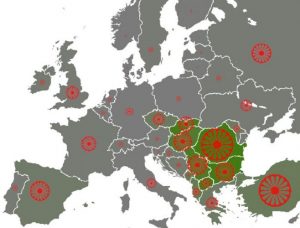Romani Language Facts
By Sarah-Claire Jordan
 Everyone at some point in their lives has heard of “gypsies”, the politically incorrect term for the Romani or Roma people. If you’ve read our previous article about the origins of the Romani people and the languages they speak, you will know that this common term used to refer to them is based on the ignorant belief that they originally came from Egypt. The most likely theory is that the Romani people are descendants of a specific caste originally from what is now India, specifically the state of Rajasthan.
Everyone at some point in their lives has heard of “gypsies”, the politically incorrect term for the Romani or Roma people. If you’ve read our previous article about the origins of the Romani people and the languages they speak, you will know that this common term used to refer to them is based on the ignorant belief that they originally came from Egypt. The most likely theory is that the Romani people are descendants of a specific caste originally from what is now India, specifically the state of Rajasthan.
One of the strongest theories of the origins of the Romani people is based on the linguistic similarities between the Romani languages and Sanskrit, among other languages from India. This is a good place to start when discussing the Romani languages, which encompass all of the varieties and dialects that are spoken by the different Romani peoples. There are around 60 different varieties and dialects, which can be categorized into several different groups: Balkan Romani, Northern Romani, Central Romani, and Vlax Romani.
Balkan Romani dialects include those spoken, or historically spoken, in the Balkans, including those spoken on the coast of the Black Sea. Northern Romani dialects are found in southern Italy, the Iberian peninsula, western Europe, and northern Europe. Central Romani dialects are come from parts of eastern Europe such as Poland and Hungary, and parts of Austria. Vlax Romani dialects are spoken in Romania, Bosnia, Serbia, and Albania.
Unfortunately, many Romani people have no knowledge of their ancestral language besides a few words. Those who do still speak it have also had to know another language, the main language of whichever region they were living in. This makes many of the dialects of Romani not very mutually intelligible, as words from the second language get incorporated into the Romani dialect spoken. In fact, since Romani was originally a language meant to be used by one very close community, the dialects differ so much from each other that they have been compared to the different Slavic languages.
Romani has been recognized as a minority language in some places, but it is only considered an official language in the Republic of Kosovo and the Municipality of Shuto Orizari in Monaco. In Romania, the country with the highest number of speakers of Romani dialects, there is a system in place for teaching the different Romani dialects spoken there. It is something rather difficult to teach, however, as there is no literary standard to teach from. One had to be developed based on certain dialects.
Though we might not realize it, there are actually a few words we use commonly in English that are actually anglicized Romani words. In American English, we use “pal”, “nark”, and “shiv”, which are all Romani in origin. British slang is full of Romani words, with more being added each day. One prime example of this is “chav”, a term used to pejoratively refer to a type of lower-class British person. The word actually comes from the Romani word “chavi”, which means child. Maybe when we start to open our eyes and see how many words and other bits of culture we have with Romani origins, we will stop discriminating against this ethnic group.
Category: Foreign Language








